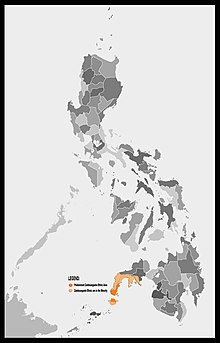Zamboangueño people
|
|
|
| Total population | |
|---|---|
| (3.5 million) | |
| Regions with significant populations | |
|
(Zamboanga City, Zamboanga Peninsula, Tawi-Tawi, Sulu, Metro Manila) (Sabah) |
|
| Languages | |
| Chavacano, Filipino, Spanish, English | |
| Religion | |
|
predominantly Roman Catholic, Islam, Protestantism, Paganism, others |
predominantly Roman Catholic, Islam, Protestantism, Paganism, others
The Zamboangueño people (Chavacano/Spanish: Pueblo Zamboangueño) are a creole ethnolinguistic nation of the Philippines and Malaysia originating in Zamboanga City. Spanish censuses record that as much as one third of the inhabitants of the city of Zamboanga possess varying degrees of Spanish and Hispanoamerican admixture. In addition to this, select cities such as Bacolod, Cebu, Iloilo and Zamboanga, which were home to military fortifications or commercial ports during the Spanish era also hold sizable mestizo communities. The Zamboangueño constitute an authentic and distinct ethnolinguistic identity because of their coherent cultural and historical heritage, most notably Chavacano, that distinguishes them from neighboring ethnolinguistic nations.
People from other ethnolinguistic nations came to Jambangan (present-day Zamboanga), when the construction of the present-day Fort Pilar began. The colonial Spanish government ordered the construction of a military fort to guard off the city from Moro pirates and slave raiders of Sulu. Labourers from Cebú, Cavite, Bohol, Negros, Panay and other islands were brought to the city to help build the fort. Eventually, these people settled in the city to live alongside and intermarried with other ethnolinguistic nations, primarily among the Subanon Ethnic <--That an entire ethnicity is descended from one clan is a grand claim. (from the Royal Ethnic lineage of Macombong and Tongab whose father is Shariff Bungsu of Brunei royalty and mother is Princess Nayac, the daughter of the late King of Kingdom of Jambangan, Datu Timuay of the Subanon ethnolinguistic nation who are the ancestors together with other ethnolinguistic nation - the Lutao,)--> Together, they would form the nucleus of the present-day Zamboangueño people. To this nucleus were added the descendants of labourers from Iloílo (also in Panay) and of soldiers from New Spain and Peru. Through intermarriage, Ilongos, Hispanoamericans and with the Spanish, they created a new culture which gradually developed a distinct identity—the Zamboangueños (Zamboangueño: magá/maná Zamboangueños; Spanish: Zamboangueños). Furthermore, because these people come from different islands and even nations and spoke different languages, they together developed a new pidgin language called Chavacano. Chavacano then evolved into a full-fledged Spanish-based creole to become the lingua franca of Zamboanga City and then the official language of the Republic of Zamboanga.
...
Wikipedia

